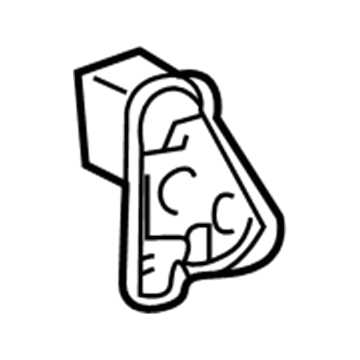×
ToyotaParts- Hello
- Login or Register
- Quick Links
- Live Chat
- Track Order
- Parts Availability
- RMA
- Help Center
- Contact Us
- Shop for
- Toyota Parts
- Scion Parts
My Garage
My Account
Cart
OEM 2003 Toyota MR2 Spyder Air Bag Sensor
Air Bag Impact Sensor- Select Vehicle by Model
- Select Vehicle by VIN
Select Vehicle by Model
orMake
Model
Year
Select Vehicle by VIN
For the most accurate results, select vehicle by your VIN (Vehicle Identification Number).
4 Air Bag Sensors found
2003 Toyota MR2 Spyder Front Sensor, Driver Side
Part Number: 89174-19135$99.97 MSRP: $120.53You Save: $20.56 (18%)Ships in 1-3 Business DaysProduct Specifications- Other Name: Sensor, Air Bag, Front; Air Bag Impact Sensor, Left; Air Bag Sensor; Sensor, Air Bag, Front Driver Side
- Position: Front Driver Side
- Part Name Code: 89174A
- Item Weight: 0.70 Pounds
- Item Dimensions: 4.7 x 2.9 x 2.2 inches
- Condition: New
- Fitment Type: Direct Replacement
- SKU: 89174-19135
- Warranty: This genuine part is guaranteed by Toyota's factory warranty.
2003 Toyota MR2 Spyder Front Sensor, Passenger Side
Part Number: 89173-19335$99.97 MSRP: $120.53You Save: $20.56 (18%)Ships in 1-3 Business DaysProduct Specifications- Other Name: Sensor, Air Bag, Front; Air Bag Impact Sensor, Right; Air Bag Sensor; Sensor, Air Bag, Front Passenger Side
- Position: Front Passenger Side
- Part Name Code: 89173A
- Item Weight: 0.70 Pounds
- Item Dimensions: 4.6 x 2.9 x 2.3 inches
- Condition: New
- Fitment Type: Direct Replacement
- SKU: 89173-19335
- Warranty: This genuine part is guaranteed by Toyota's factory warranty.
2003 Toyota MR2 Spyder Front Sensor, Driver Side
Part Number: 89174-19115$99.97 MSRP: $120.53You Save: $20.56 (18%)Ships in 1-3 Business DaysProduct Specifications- Other Name: Sensor, Air Bag, Front; Air Bag Impact Sensor, Left; Air Bag Sensor; Sensor, Air Bag, Front Driver Side
- Position: Front Driver Side
- Replaces: 89174-19025
- Part Name Code: 89174A
- Item Weight: 0.70 Pounds
- Item Dimensions: 4.7 x 2.8 x 2.3 inches
- Condition: New
- Fitment Type: Direct Replacement
- SKU: 89174-19115
- Warranty: This genuine part is guaranteed by Toyota's factory warranty.
2003 Toyota MR2 Spyder Front Sensor, Passenger Side
Part Number: 89173-19315$99.97 MSRP: $120.53You Save: $20.56 (18%)Ships in 1-3 Business DaysProduct Specifications- Other Name: Sensor, Air Bag, Front; Air Bag Impact Sensor, Right; Air Bag Sensor; Sensor, Air Bag, Front Passenger Side
- Position: Front Passenger Side
- Replaces: 89173-19215
- Part Name Code: 89173A
- Item Weight: 0.70 Pounds
- Item Dimensions: 4.8 x 2.9 x 2.3 inches
- Condition: New
- Fitment Type: Direct Replacement
- SKU: 89173-19315
- Warranty: This genuine part is guaranteed by Toyota's factory warranty.
2003 Toyota MR2 Spyder Air Bag Sensor
Looking for affordable OEM 2003 Toyota MR2 Spyder Air Bag Sensor? Explore our comprehensive catalogue of genuine 2003 Toyota MR2 Spyder Air Bag Sensor. All our parts are covered by the manufacturer's warranty. Plus, our straightforward return policy and speedy delivery service ensure an unparalleled shopping experience. We look forward to your visit!
2003 Toyota MR2 Spyder Air Bag Sensor Parts Q&A
- Q: How to remove and install the Air Bag Sensor Assembly on 2003 Toyota MR2 Spyder?A: Before separating the Air Bag Sensor Assembly drivers should remove their floor carpet and disconnect both the wire clamp along with Air Bag sensor connectors when the sensor assembly remains fully installed. You need to undo the 3 screws that fasten the Air Bag sensor assembly using either the Torx wrench T40 (Part No.09042-00020) or its equivalent local tool. The proper installation requires new SRS components and excludes directional reuse of any Air Bag sensor components which survived a crash or sensor repairs for secondary use. A Torx wrench with 3 screws can fix the Air Bag sensor assembly with maximum torque set at 20 N.m (205 kgf.cm, 15 ft.lbf). Connect the Air Bag sensor connectors before installing the wire clamp followed by reattaching the floor carpet. Once the sensor assembly is properly installed you should check the connector status and verify the specified torque on the sensor assembly while discarding it for a new unit in case of damage. Check for loose wiring of the SRS components after their installation by shaking the sensor assembly while also ensuring they do not encounter any pinching or contact with other parts.














